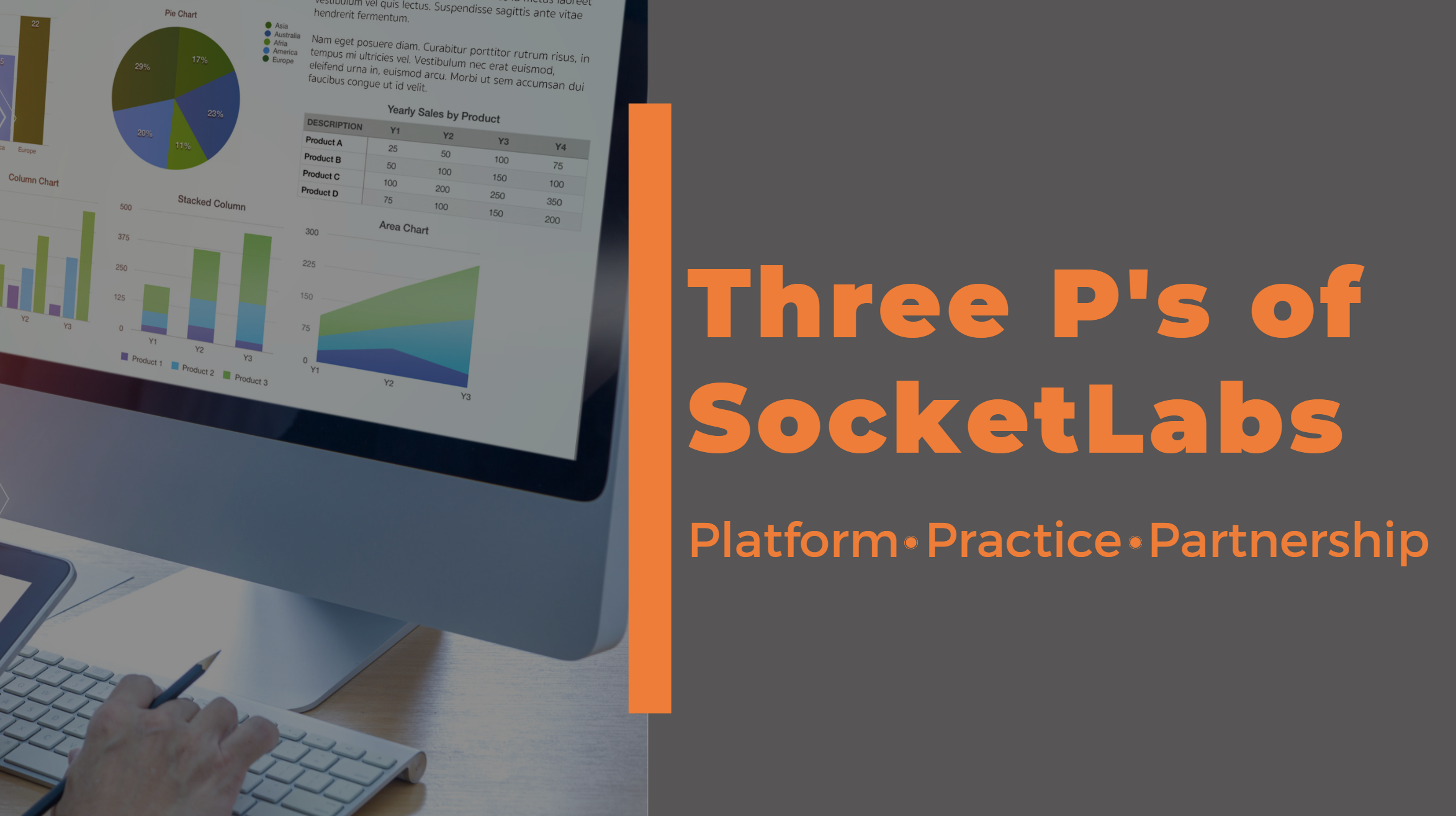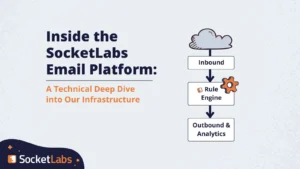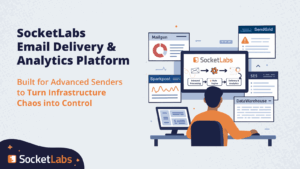
Managing your own email infrastructure can be a challenge. The amount of expertise, time, and financial investment needed to get it right can be a real drain on your business. Even if your overall delivery rates seem stellar, it’s still hard to know if you are really getting the most out of your email efforts. Working with an email service provider (ESP) can be an easier way to fully optimize your email efforts with less of the headache. Still, not all ESPs are created equal. With different technology, deliverability practices, and on-hand expertise, each ESP will be different. At SocketLabs, we know from experience that email success comes from three foundational pillars – something that we call the three P’s: platform, practice, and partnership.
- Platform – a superior sending platform that incorporates the latest email innovations
- Practice – enabling customers to follow best practices by sharing our knowledge and know-how
- Partnership – Serving as your high-value email delivery partner is to help you successfully evolve and adapt to the complex and ever-changing world of email
Your choice of platform, practices and partner make all the difference in your email delivery success.
Platform
If you are trying to find a suitable long-term ESP partner, there are several important platform qualities that contribute to your sender reputation and help drive deliverability rates higher. They are:
- Technical maturity and reputation strength
- Message encryption for security and privacy
- Comprehensive authentication support
- Stream-level performance tracking and optimization
- Continuous flexibility and scalability
SocketLabs’ proprietary cloud-based technology blends three critical components to form a uniquely powerful email delivery ecosystem: 1. The Hurricane™ Mail Transfer Agent (MTA) – Our proprietary high-volume email delivery engine 2. StreamScore™ – Our unique stream-specific email authentication, performance, and quality analytics tool 3. SendFlex™ – Our robust multi-stream account and traffic configuration system:
- Intelligent traffic routing based on over a decade of delivery data
- Advanced encryption standards to prevent “man-in-the-middle” cyberattacks
- Simplified email link encryption
- Automated engagement tracking security features
Technical Maturity and Reputation Strength
Experience is everything when it comes to learning and adapting to the rules of email delivery. System availability and stability are critical but should be considered bare minimum qualifications. What you should really be looking for is an ESP that boasts experience in and for different industries, use cases, and workflow complexities. The multi-layer needs of an agency are different than those of a SaaS application. And if your development team will be building workflows around your email functionality, you need to ensure that your APIs can support customized data handling. Sending reputation is further enhanced by adherence to email management rules, such as CAN-SPAM and European GDPR regulations, so look for a compliant ESP. Finally, ESPs must actively manage their platforms to remove any mail activity that violates best practices.
“An ESP platform with a solid track record provides immediate deliverability benefits. These include a proven sender reputation and intelligent traffic shaping – based on machine learning – for tailoring deliveries to mailbox providers.”
Message Encryption for Security and Privacy
The large-scale mailbox providers make the rules. If that isn’t clear yet, it’s worth formally stating now. And, large-scale mailbox providers have been pushing for email encryption for more than five years. Secure Sockets Layer (SSL) and Transport Layer Security (TLS) are methods of encrypting traffic while in transit. TLS is the successor to SSL, but the differences are negligible in most cases. By using SSL/TLS to protect your email, you maintain the confidentiality of information in your messages while in transit. With the power of Google behind it, adoption is increasingly widespread. In fact, the company’s data from the start of 2014 shows a near 100% growth rate in SSL/TLS implementation across its mail streams. So, your ESP of choice needs to be knowledgeable in this area, too.
Comprehensive Authentication Support
There are two additional steps your ESP should be taking to tighten up the security of your messages in transit and build your sender reputation. These are: 1. Implementing DKIM and SPF Authentication 2. Setting up DMARC
DomainKeys Identified Mail (DKIM) and Sender Policy Framework (SPF) are forms of email authentication. SPF proves to ISPs that your mail is from you, and you are who you say you are. DKIM uses an encryption key and digital signature to defend against malicious modification of your in-transit email messages by ensuring that what arrives in your recipient inbox was not faked or altered. In the meantime, an SPF record is an email authentication protocol that allows you to specify which IP addresses are authorized to send email on behalf of your domain.
If yours is a compliance-driven organization, Domain Message Authentication Reporting & Conformance (DMARC) support is necessary to help detect and prevent email spoofing (for example, to prevent a phishing scam that looks like the email is coming from your bank or PayPal, prompting you to click on a link to reset your password or to give them your information). DMARC unifies SPF and DKIM authentication into a common framework and ensures that legitimate email is properly authenticated against these standards. Specifically, DMARC allows a domain owner to publish policies in the DNS and tells remote mailers what to do with messages that do not align with these polices. If mail coming from your domain is suspected of being fraudulent, the messages are usually blocked (this is dependent upon how DMARC is configured, but a general rule of thumb).
“Mailbox providers prefer to receive authenticated email because authentication makes it easier to block harmful uses of email, such as phishing and spam.”
Stream-level Performance Tracking and Optimization
Your ESP must absolutely be able to help you adjust and hone your email programs over time, using quantitative and qualitative methods to keep deliverability rates high as mailbox providers continuously change the rules of the game. Doing so requires understanding how and why certain messages are failing to reach the inbox, and then responding as necessary. First and foremost, your ESP must attack the issue from a best-practice-based perspective (this approach of segmenting and tracking email performance will be discussed later in this ebook). Second, your ESP must help you understand how well your individual messages perform and where further optimization is possible.
Continuous Flexibility and Scalability
Every company’s communication needs and goals are different. That’s why flexibility is critical. As your business grows, so does the number of email streams that your ESP must handle. You need confidence your provider can seamlessly expand and evolve with you. A healthy email ecosystem provides options for customization, offering more than just a one-size-fits-all approach. There should be guidance on how to use this flexibility to optimize message delivery. Be sure you can discuss customizations or system configurations that can improve your experience. For example, setting custom sending domains and IP whitelists are great choices to help build the corporate brand and the reputation of your messages with inbox providers, but these features need to be properly configured before you get started. And as your business grows, scalability becomes very relevant. Can your ESP easily meet the sending volumes you may require?
“Control of the technology stack, a high rate of innovation, and a willingness to customize the client experience are essential qualities for an ESP, given the pace of change surrounding email communications.”
Practice
You can always take actions today that will improve your IP reputation and enhance your future deliverability. The following are key strategies and deliverability recommendations that our strategists often see go unappreciated by many organizations – and which a good ESP should help you monitor and address:
- Carefully segment your email streams
- Apply strong and authentication and security
- Tightly define your message and campaign audiences
- Compose messages that are both engaging and compliant
- Warm up your IP addresses and new email patterns
- Monitor all messages for deliverability, open rates, and engagement
- Carefully segment your email streams
The simple rule is, the more granular the better. Starting at a high level, you should separate marketing and transactional email streams. When the major inbox providers encounter messages that are obviously marketing, they will often defer or limit the rate at which they are accepted and delivered while they monitor recipient reaction. If transactional messages are mixed into the same email stream, these higher priority messages may also suffer the same limitations. To create stream separation, you can start by using different root (or “from”) addresses for each type, for example using “[email protected]” for transactional messages and “promotions@yourdomain. com” for marketing messages. Many organizations, large and small, segregate distinct streams of mail by sending them from their own IP address. This physical separation prevents any inbox confusion, allows each stream to develop its own reputation, and simplifies performance tracking process.
Apply Strong Authentication and Security
The currency of email communication is almost always some degree of personal and/or private information, so messages naturally require at least a minimum level of security. Moreover, you simply cannot ignore the basic security standards that will help ensure deliverability of time-critical content and information. Implementing industry authentication standards, such as SPF, DKIM, and DMARC, provides protections that make your messages more trustworthy in the eyes of mailbox providers. By embracing these practices, you’ll send the necessary signals to all mailbox platforms that your mail originates from a trusted source and has not been tampered with in transit.
Tightly Define Your Message and Campaign Audiences
Contrary to popular belief, increasing your message volume doesn’t equal email campaign success. In fact, it can be quite the opposite. A high volume of email sent to “the wrong audience” (those who are not an ideal fit for the information or service offering that’s being presented) can be extremely detrimental to email deliverability. The result of this lazy targeting approach is that the receiving individuals have a much higher tendency to categorize your incoming messages as spam or unsubscribe from your mailing list altogether. As this occurs, the reputational damage that is caused reduces your status with mailbox providers and causes further restrictions on the deliverability of every subsequent message you push out.
Compose Messages that are Both Engaging and Compliant
There are countless best practices that fit under the overarching theme of good email design. They’re all aimed at meeting legal requirements and fostering positive recipient engagement. Positive engagement, in turn, is a significant driver of reputation, which will boost future deliverability rates. At a minimum, you need to build programs that:
Follow local email laws – The United States, Canada, and the EU have different laws surrounding email spam – and many EU countries have their own additional standards and rules. As the sender, it’s incumbent upon you to know and follow applicable regulations. In other words, ignorance is not a defense. It’s important to note that the recipient’s location, and not your sender location, determines the laws that must be followed.
Clearly identify the source and reason for your email – Your message should clearly answer the basic questions of: Who is sending this message? What is the purpose of this message? Why am I receiving this message? This is especially true if it has been a while since the user last interacted with you. It’s also advisable to use a “from address” that is easily understandable and relatable (such as “[email protected]”) and to brand your messages by including your company name, logo, and colors.
Feature prominent unsubscribe buttons – An easily visible and accessible unsubscribe link or button will have enormous positive impact on your deliverability. Even if the recipients have opted in, some of them will want to opt out at some point. For marketers, this is more than just a good idea, it’s a requirement to stay in compliance with CAN-SPAM laws.
Use a “reply to” address – A “reply to” address tells your recipients that you want to hear from them –and you do. In recent years, this metric has become a major factor in helping mailbox providers, especially Gmail, determine how to handle messages. So, there’s a deliverability benefit to receiving replies to your transactional email. More importantly, the mere presence of a “no-reply” address could negatively impact your deliverability.
Ensure recipient consent and consistent list scrubbing – Using bulk email lists or sending unsolicited messages to unfamiliar or guessed email addresses is simply dangerous. That’s because the mailbox providers will take notice of the inevitable spam complaints, blocks, and unread message deletions – and ding your reputation accordingly. Conversely, they will also note and reward you if your email has high clicks, opens, saves, and forwards.
Warm Up Your IP Addresses and New Email Patterns
IP warming is the process of gradually increasing the volume of emails sent from an IP address over time. It’s part art and part science. A rather conservative and very general method used to warm an IP address is to equally distribute sending across all mailbox providers. For example, if you’re sending 100,000 emails in a month, you might divide those 100,000 emails to send equally each day and to each mailbox provider. So, you might send 1,111 to your Gmail addresses, 1,111 to Yahoo! addresses, and 1,111 to Verizon addresses until you hit 100,000 messages that month. This safe and calculated approach will help your IP address stay under the radar of providers’ spam traps and content filters.
This same approach applies when sending any new stream of email traffic. Mailbox providers will always be skeptical of new traffic patterns until they can be proven safe. As the providers observe that your deliverability/engagement rates are healthy, your reputation will grow, and you can increase your sending volumes.
Monitor All Messages for Deliverability, Open Rates, and Engagement
Because transactional emails are wanted and expected, many organizations think they don’t need to be checked for opens, clicks, bounces, and complaints. But, you can still learn from the behaviors of your transactional email recipients. Plus, even the best quality email (transactional or marketing) can land in the spam folder—and, that’s certainly something you need to know about so that it can be quickly resolved. Delivery confirmation is essential if your messages are offering information regularly shared with customers (i.e. account summaries or reports) or are being sent as an automated response to a customer request (i.e. password resets or technical support tickets). In these, and many other cases, delivery and engagement can be the difference between keeping and losing a customer. Further, optimizing inbox rates will help reduce the need for manual interventions, as well as your operational costs.
Partnership
Beyond providing the ideal combination of technical platform and best practices expertise, SocketLabs is committed to creating performance-driven partnerships with our customers – irrespective of their industry, geography or unique business challenges.
We invigorate SaaS platforms, mobile apps, and custom applications by plugging them in to an unmatched email experience based on SocketLabs’ proprietary email science. We provide the data, analysis, and expertise to help you make the continuous adjustments and improvements that are necessary to succeed over the long haul. As a pioneer in the ESP market with a 13 year track record of excellence, we are specialists in dealing with change. Our customer-first spirit means that we’re there to help you as needed, to continually drive inbox optimization and ROI in the face of a world and industry that is in a constant state of change.
Partnership is what truly distances SocketLabs from the pack. We support each solution with world-class, personalized service. Our support and consulting teams help companies in virtually every industry innovate the way they separate, analyze, visualize, and manage email strategy to maximize audience engagement and achieve business goals. Our high-touch user experience and unique consultative methodology helps customers avoid the pitfalls that erode email effectiveness.
“Our founders have been creating cutting-edge email solutions for over 20 years and built a customer support organization that considers ‘responsiveness and satisfaction’ key performance objectives.”







